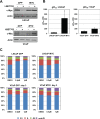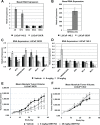Inhibition of BET bromodomain proteins as a therapeutic approach in prostate cancer
- PMID: 24293458
- PMCID: PMC3926837
- DOI: 10.18632/oncotarget.1572
Inhibition of BET bromodomain proteins as a therapeutic approach in prostate cancer
Abstract
BET (bromodomain and extra-terminal) proteins regulate gene expression through their ability to bind to acetylated chromatin and subsequently activate RNA PolII-driven transcriptional elongation. Small molecule BET inhibitors prevent binding of BET proteins to acetylated histones and inhibit transcriptional activation of BET target genes. BET inhibitors attenuate cell growth and survival in several hematologic cancer models, partially through the down-regulation of the critical oncogene, MYC. We hypothesized that BET inhibitors will regulate MYC expression in solid tumors that frequently over-express MYC. Here we describe the effects of the highly specific BET inhibitor, I-BET762, on MYC expression in prostate cancer models. I-BET762 potently reduced MYC expression in prostate cancer cell lines and a patient-derived tumor model with subsequent inhibition of cell growth and reduction of tumor burden in vivo. Our data suggests that I-BET762 effects are partially driven by MYC down-regulation and underlines the critical importance of additional mechanisms of I-BET762 induced phenotypes.
Figures





References
-
- McCabe M. T, Ott H. M, Ganji G, Korenchuk S, Thompson C, Van Aller G. S, Liu Y, Graves A. P, Della Pietra A, III, Diaz E, LaFrance L. V, Mellinger M, Duquenne C, Tian X, Kruger R. G, McHugh C. F, et al. EZH2 inhibition as a therapeutic strategy for lymphoma with EZH2-activating mutations. Nature. 2012;492:108–112. - PubMed
-
- Knutson S. K, Warholic N. M, Wigle T. J, Klaus C. R, Allain C. J, Raimondi A, Porter Scott M, Chesworth R, Moyer M. P, Copeland R. A, Richon V. M, Pollock R. M, Kuntz K. W, Keilhack H. Durable tumor regression in genetically altered malignant rhabdoid tumors by inhibition of methyltransferase EZH2. Proc Natl Acad Sci U S A. 2013;110:7922–7927. - PMC - PubMed
-
- Daigle S. R, Olhava E. J, Therkelsen C. A, Majer C. R, Sneeringer C. J, Song J, Johnston L. D, Scott M. P, Smith J. J, Xiao Y, Jin L, Kuntz K. W, Chesworth R, Moyer M. P, Bernt K. M, Tseng J. C, et al. Selective killing of mixed lineage leukemia cells by a potent small-molecule DOT1L inhibitor. Cancer Cell. 2011;20:53–65. - PMC - PubMed
-
- Chung C. W, Coste H, White J. H, Mirguet O, Wilde J, Gosmini R. L, Delves C, Magny S. M, Woodward R, Hughes S. A, Boursier E. V, Flynn H, Bouillot A. M, Bamborough P, Brusq J. M, Gellibert F. J, et al. Discovery and characterization of small molecule inhibitors of the BET family bromodomains. J Med Chem. 2011;54:3827–3838. - PubMed
MeSH terms
Substances
LinkOut - more resources
Full Text Sources
Other Literature Sources
Molecular Biology Databases

